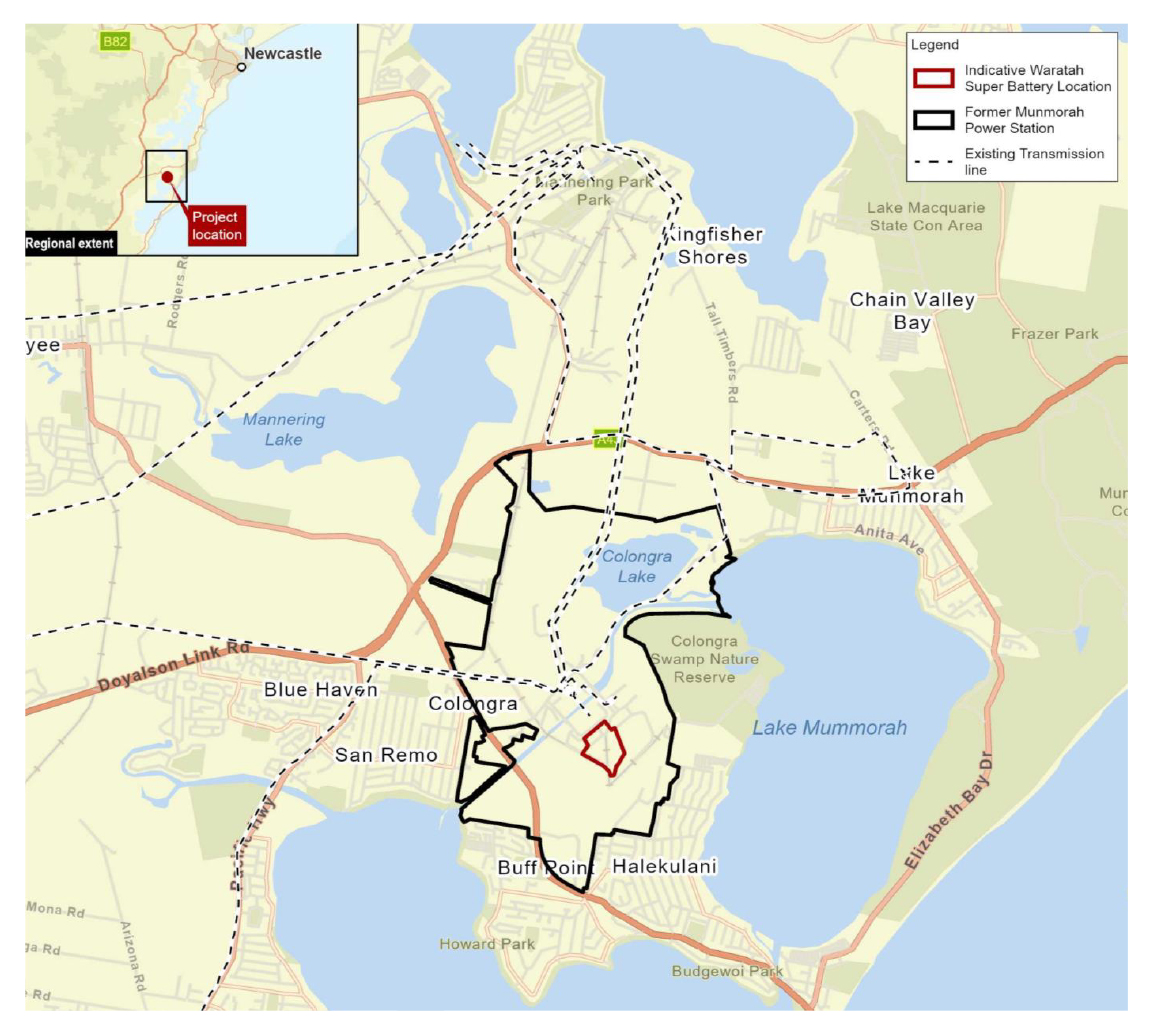To ensure NSW continues to have reliable energy supply following the anticipated closure of the Eraring Power Station in 2025, the NSW Government is delivering the Waratah Super Battery (WSB) project. The WSB project is a System Integrity Protection Scheme (SIPS) designed to act as a ‘shock absorber’ in the event of any sudden power surges, including from bush fires or lightning strikes.
WSB project components:
- A SIPS Service provided by a Battery Energy Storage System (BESS) located at the former Munmorah coal-fired power station that is capable of providing a guaranteed continuous active power capacity of at least 700 MW and a guaranteed useable energy storage capacity of at least 1400 MWh.
- Paired Generation Services provided by multiple generators across NSW that are capable of providing technical services to support the SIPS.
- Network Augmentations and SIPS Control provided by Transgrid in its role as Network Operator that includes the SCADA, telecommunications, minor augmentations and control scheme equipment required to operate the SIPS.
The WSB project provides a virtual transmission solution that unlocks latent capacity in the existing transmission system, allowing electricity consumers in the Sydney, Newcastle, Wollongong demand centres to access more energy from existing generators.

The WSB project is being delivered as a Priority Transmission Infrastructure Project, or PTIP, under the Electricity Infrastructure Investment Act 2020 (the Act), and is the first PTIP to be delivered under the Act.
The WSB project is expected to stimulate up to $1 billion in private investment into new energy storage and associated network augmentations, generate significant capital investment in the Hunter and Central Coast regions, and support over 100 jobs during construction.
Transgrid appointed as Network Operator
On 14 October 2022, the Minister for Energy appointed Transgrid as Network Operator and formally directed Transgrid to carry out the WSB project as a PTIP under the Act, published in the NSW Gazette here.
As Network Operator, Transgrid will coordinate the delivery of the project components described above and will be responsible for operating the SIPS once the WSB project is operational.
Akaysha Energy appointed as SIPS Service Provider
EnergyCo in its role as Infrastructure Planner for the WSB project, appointed Akaysha Energy as the SIPS Service Provider following a competitive procurement process conducted throughout 2022.
Akaysha Energy is responsible for the construction of a BESS located at the former Munmorah coal-fired power station that is capable of providing a guaranteed continuous active power capacity of at least 700 MW and a guaranteed useable energy storage capacity of at least 1400 MWh for the purposes of providing the SIPS Service.
The physical size of the of BESS is expected to be 850 MW / 1680 MWh which is understood to one of the largest committed BESSs in the world, both in terms of power and energy storage capacity. This oversizing of the BESS allows for degradation of the battery over time to ensure security of supply. It also allows Akaysha Energy to utilise the excess capacity to tap into additional revenue streams, putting downward pressure on the cost of the SIPS Service provided to NSW consumers.

Munmorah Site
The WSB project will be developed within the former Munmorah Power Station site at 301 Scenic Drive, Colongra (the Munmorah Site).
On 2 September 2022, the Minister for Planning declared the potential development of the WSB project on the Munmorah site as Critical State Significant Infrastructure (CSSI), in recognition of the critical nature of the project to NSW’s energy security.
For further information, you can download a newsletter about the Waratah Super Battery – Munmorah.

EnergyCo prepared a comprehensive Environmental Impact Statement (EIS) which assessed the impacts of the WSB project on the environment and surrounding communities. As part of the preparation of the EIS, EnergyCo consulted with a range of stakeholders, including residents in the surrounding community.
The EIS was publicly exhibited between 11 November and 8 December 2022 on the Department of Planning and Environment’s major projects website.
Following the consultation period and after review of submissions, the NSW Government granted planning approval for the construction and operation of the Waratah Super Battery Project on 23 February 2023.
Approved management plans and strategies
After planning approval was granted for the Waratah Super Battery, a number of management plans and strategies required under the approval have been approved by the Department of Planning and Environment (DPE). The approved management plans and strategies can be viewed below or on the DPE’s major projects website.
- Biodiversity Management Plan
- Approval of Biodiversity Management Plan
- Approval of Dilapidation Survey
- Traffic Management Plan Stage 1
- Approval of Traffic Management Plan Stage 1
- Environmental Management Strategy Approval
- Environmental Management Strategy
- Traffic Management Plan Stage 2
On 31 May 2023, Akaysha Energy began construction on the Waratah Super Battery. Construction is expected to be completed before August 2025.
Regulatory
The WSB project is composed of two contestable components (a SIPS Service and Paired Generation Services) and a non-contestable component (Network Augmentations and SIPS Control). The Australian Energy Regulator (AER) in its role as Regulator under the Act, is required to make revenue determinations for each component of the WSB project.
Under the Act, the Scheme Financial Vehicle (SFV) must pay the Network Operator in accordance with the amounts set out in the AER’s revenue determination. The SFV recovers the cost of the NSW Electricity Infrastructure Roadmap from Distribution Network Service Providers who in turn recover those costs from NSW electricity consumers through network charges on their retail bills.
On 14 December 2022, a revenue determination for the SIPS Service component of the WSB project was published by the AER on its website.
Discover more from Energy Planning
Subscribe to get the latest posts sent to your email.
